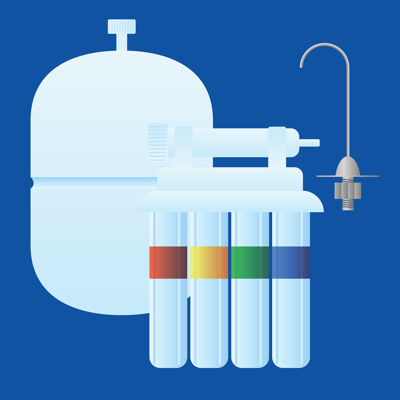Reverse Osmosis
 Whether your home is connected to a municipal water supply network or you have drilled your own well, purity of water should be one of your biggest concerns. There are a number of filtration techniques, which allow water to attain a level of purity, and reverse osmosis is just one of them.
Whether your home is connected to a municipal water supply network or you have drilled your own well, purity of water should be one of your biggest concerns. There are a number of filtration techniques, which allow water to attain a level of purity, and reverse osmosis is just one of them.
What is osmosis?
The reverse osmosis filtration technology was developed based on a natural process that is osmosis. It is a process when molecules of a weaker solution pass through a semi-permeable membrane to a stronger one. In a way, it is like a sponge absorbing water or plant roots pulling water in from earth. This phenomenon is natural and very common.
A semi-permeable membrane lets through some stuff and holds another. Particularly, it is permeable for water, but not for contaminants and sediments. It is the same as an insect screen that has holes big enough for air, but too small for flies, mosquitoes, etc., to pass through.
What is reverse osmosis?
Contrary to natural osmosis, in reverse osmosis a stronger (saltier) solution migrates to a weaker one through a semi-permeable membrane. However, it will not go by itself, because it takes pressure to push a substance through the semi-permeable membrane. Unneeded dissolved stuff is held by the membrane in the same way. Reverse osmosis is unusual in nature, because it involves pressure that is much greater than in natural osmosis, which has to be created artificially.
How does it work?
The effect of reversed osmosis is achieved through the use of a pump, which creates pressure and forces the contaminated water to pass through the membrane. The membrane will hold up to 99% of contaminants. The more contaminated the feed water is, the higher pressure it requires.
To keep the membrane clean, some water that does not pass through the semi-permeable membrane, is drained from it. It has a higher concentration of salts than feed water. The water that passes through the filter has the lowest concentration of salts and other contaminants. This two-outlet (cross-filtration) system allows users to keep the membrane functional for a longer period and prolongs its life.
The semi-permeable membrane rejects substances based on their charge and molecular weight. For instance, it won’t let pass a substance whose molecular weight exceeds 200. Also, it will hold substances with a high ionic charge. This is the reason why reverse osmosis does not remove gases (CO2), because they have low charges. This kind of filtration removes colloids, organic matter, ionized salts, bacteria, pyrogens, etc., from water.
Structure
A cold water line valve is connected to the cold (feed) water pipe. It directs water to the pre-filter section, which removes large particles and debris. Then the water runs to the semi-permeable membrane, where the filtration actually takes place. After that, the purified water passes post-filtration and enters a storage tank. Now it is ready for use.
Water that has passed reverse osmosis filtration is great for cooking and other domestic needs. There are RO systems of various types of modifications, some of which are quite affordable and easy to use.


